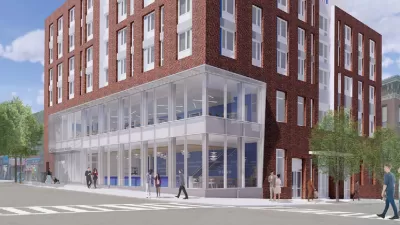A 298-unit, 18-story tower in Pacific Park Brooklyn opened its doors to new renters in various categories of affordability over five months ago. 27% remain empty in the higher income tiers, and unlike market-rate units, the asking rent won't drop.
Posts on vacant housing in Planetizen often deal with what to do with abundance of empty, blighted homes in shrinking Rust Belt cities like Cleveland. Vacant properties exist in New York City as well, and homeless advocates are pressuring the city to track them. But how can one explain vacancies in newly constructed, all-affordable buildings?
Case in point: 535 Carlton in what is now called Pacific Park Brooklyn, renamed from Atlantic Yards in 2014 by the joint development company, Greenland Forest City Partners "after the Chinese government-owned Greenland Group bought a 70% stake in 15 towers" from Forest City Ratner.
The building broke ground in December 2014. "Mayor Bill de Blasio pronounced the affordability criteria for the development '100% affordable,' and credits the development toward his goal of adding and preserving 200,000 affordable residential units in the next 10 years," notes the Planetizen post that lists the five income tiers eligible for prospective tenants.
Units were allotted through a city-housing lottery, reports Ginia Bellafante, Big City columnist for The New York Times on Nov. 17. No problem renting out the 25 percent of apartments to tenants who qualified for the "extremely low and "very low" income categories, based on average median income.
Half the apartments, though, were slated for middle-income occupants, and although the lottery received more than 93,000 applications, an inadequate number of qualified tenants in the highest income brackets has left 80 apartments empty.
I recall in my last apartment building, the landlord would lower the asking rent based on how long it remained on the market. That won't be the case in the "all-affordable" 535 Carlton though, explains Bellafante.
The way that these public-private partnerships are structured and underwritten, however, the revenue from more expensive units helps offset the rents of those apartments intended for lower-income tenants (some one-bedroom apartments at 535 Carlton, for example, cost as little as $589 a month). Developers can’t just lower the rents to accommodate demand and keep the projects financially viable.
The developer, Greenland Forest City Partners, is now advertising them via StreetEasy, social media and so on.
No word as to whether the property manager is offering "generous incentives, usually in the form of one, two, or even three months of free rent offered to those who sign leases for high-end apartments," as noted in an August 2016 post on the oversupply of luxury units in Brooklyn.
Additional reading on 535 Carlton:
- City Limits: "Atlantic Yards Developers Struggle to Find Tenants for Higher-Income Affordable Units" | November 3, 2017
- Curbed NY: "Pacific Park welcomes first residents to its all-affordable, COOKFOX-designed rental," Jun 12, 2017
FULL STORY: At $3,700 a Month, ‘Affordable’ Apartments Go Begging

Alabama: Trump Terminates Settlements for Black Communities Harmed By Raw Sewage
Trump deemed the landmark civil rights agreement “illegal DEI and environmental justice policy.”

Study: Maui’s Plan to Convert Vacation Rentals to Long-Term Housing Could Cause Nearly $1 Billion Economic Loss
The plan would reduce visitor accommodation by 25% resulting in 1,900 jobs lost.

Why Should We Subsidize Public Transportation?
Many public transit agencies face financial stress due to rising costs, declining fare revenue, and declining subsidies. Transit advocates must provide a strong business case for increasing public transit funding.

Paris Bike Boom Leads to Steep Drop in Air Pollution
The French city’s air quality has improved dramatically in the past 20 years, coinciding with a growth in cycling.

Why Housing Costs More to Build in California Than in Texas
Hard costs like labor and materials combined with ‘soft’ costs such as permitting make building in the San Francisco Bay Area almost three times as costly as in Texas cities.

San Diego County Sees a Rise in Urban Coyotes
San Diego County experiences a rise in urban coyotes, as sightings become prevalent throughout its urban neighbourhoods and surrounding areas.
Urban Design for Planners 1: Software Tools
This six-course series explores essential urban design concepts using open source software and equips planners with the tools they need to participate fully in the urban design process.
Planning for Universal Design
Learn the tools for implementing Universal Design in planning regulations.
Smith Gee Studio
Alamo Area Metropolitan Planning Organization
City of Santa Clarita
Institute for Housing and Urban Development Studies (IHS)
City of Grandview
Harvard GSD Executive Education
Toledo-Lucas County Plan Commissions
Salt Lake City
NYU Wagner Graduate School of Public Service




























